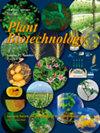Gene-flow investigation between garden and wild roses planted in close distance
IF 1.1
4区 生物学
Q4 BIOTECHNOLOGY & APPLIED MICROBIOLOGY
引用次数: 0
Abstract
Rose is a major ornamental plant, and a lot of cultivars with attractive morphology, color and scent have been generated by classical breeding. Recent progress of genetic modification produces a novel cultivar with attractive features. In both cases, a major problem is the gene-flow from cultivated or genetically modified (GM) plants to wild species, causing reduction of natural population. To investigate whether gene-flow occurs in wild species, molecular analysis with DNA markers with higher efficient technique is useful. Here we investigated the gene-flow from cultivated roses (Rosa×hybrida) to wild rose species planted in close distance in the field. The overlapping flowering periods and visiting insects suggest that pollens were transported by insects between wild and cultivated roses. We examined the germination ratio of seeds from wild species, and extracted DNA and checked with KSN and APETALA2 (AP2) DNA markers to detect transposon insertions. Using two markers, we successfully detected the outcross between wild and cultivated roses. For higher efficiency, we established a bulking method, where DNA, leaves or embryos were pooled, enabling us to that check the outcross of many plants. Our results suggest that wild species and garden cultivars can cross in close distance, so that they should be planted in distance, and checked the outcross with multiple DNA markers.近距离种植的花园玫瑰与野生玫瑰的基因流动研究
玫瑰是一种重要的观赏植物,通过经典育种已经培育出了许多形态、色泽、香味俱佳的玫瑰品种。基因改造的最新进展产生了一种具有吸引人特征的新品种。在这两种情况下,一个主要问题是基因从栽培或转基因(GM)植物流向野生物种,导致自然种群减少。为了研究野生物种中是否存在基因流动,利用DNA标记进行分子分析是一种有效的方法。本文研究了栽培玫瑰(Rosa×hybrida)与近距离种植野生玫瑰之间的基因流。花期和来访昆虫的重叠表明,花粉是通过昆虫在野生玫瑰和栽培玫瑰之间传播的。我们检测了野生种种子的发芽率,提取了DNA,用KSN和aptala2 (AP2) DNA标记检测转座子插入。利用两个标记,我们成功地检测到了野生玫瑰与栽培玫瑰的异种杂交。为了提高效率,我们建立了一种批量方法,将DNA、叶子或胚胎放在一起,使我们能够检查许多植物的异种杂交。结果表明,野生品种与栽培品种可以近距离杂交,宜远距离种植,并采用多DNA标记对异交进行了检验。
本文章由计算机程序翻译,如有差异,请以英文原文为准。
求助全文
约1分钟内获得全文
求助全文
来源期刊

Plant Biotechnology
BIOTECHNOLOGY & APPLIED MICROBIOLOGY-PLANT SCIENCES
CiteScore
2.90
自引率
18.80%
发文量
45
审稿时长
6-12 weeks
期刊介绍:
Plant Biotechnology is an international, open-access, and online journal, published every three months by the Japanese Society for Plant Biotechnology. The journal, first published in 1984 as the predecessor journal, “Plant Tissue Culture Letters” and became its present form in 1997 when the society name was renamed to Japanese Society for Plant Cell and Molecular Biology, publishes findings in the areas from basic- to application research of plant biotechnology. The aim of Plant Biotechnology is to publish original and high-impact papers, in the most rapid turnaround time for reviewing, on the plant biotechnology including tissue culture, production of specialized metabolites, transgenic technology, and genome editing technology, and also on the related research fields including molecular biology, cell biology, genetics, plant breeding, plant physiology and biochemistry, metabolic engineering, synthetic biology, and bioinformatics.
 求助内容:
求助内容: 应助结果提醒方式:
应助结果提醒方式:


